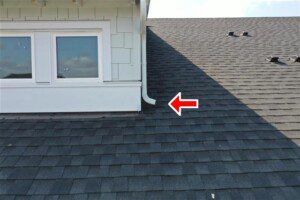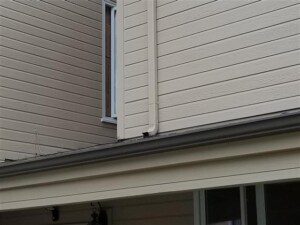Downspouts are an essential part of the stormwater management system of a home, which includes gutters, downspouts, and downspout drains. While gutters collect rain water at the roof eaves, downspouts direct this water to underground stormwater system that sends to water out to the street or downspouts may discharge in a properly sloped yard at least 6 feet away from the foundation.

As the water runs from the downspout to the lower gutter, the shingles between these areas experience increased wear and deterioration. As shingle granules are eroded from the surface of the shingles, the exposed asphalt is deteriorated which can cause premature aging and a shorter life span for the shingles. This increased water flowing across the shingles can also allow organic growth such as moss, lichen, and algae to grow on the roof surface. These biological growths can damage the roof shingles and can hold additional water against the roof, resulting in further damage.
Since the area beneath a downspout draining onto a lower roof has increased water running over the shingle surface, leakage may occur in this area from forced water penetration if conditions are right. If there is enough water volume and intensity on the shingles, water may be forced between the shingles and under the roof surface. This can result in leakage and extensive damage if the leak goes undetected for extended periods of time.

Rain water can also go in unintended directions when pushed through a downspout emptying onto a lower roof. Water is expected to flow straight down and roof surfaces are designed with this in mind. However, when water is pushed with significant force through a downspout before emptying near a roof edge, this can force the water towards the edge and over the rakes before dropping to the ground, missing the gutter system and resulting in potential water intrusion behind the flashing and siding or through the foundation.
Solutions for downspouts installed in this manner are typically the installation of downspout extensions or splash pans to direct the water to the lower gutters and protect the shingles and exterior walls from accelerated deterioration. While downspout extensions are often not installed due to cosmetic reasons, these can help to prevent a significant amount of deterioration and prevent leakage in the future.
